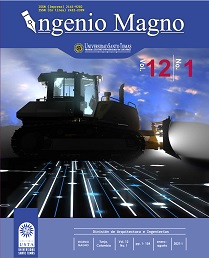Avaliação experimental do desempenho energético de um freezer comercial usando R1234yf em diferentes níveis de carga térmica
##plugins.themes.bootstrap3.article.main##
Resumo
Downloads
##plugins.themes.bootstrap3.article.details##
DECLARACIÓN DE ORIGINALIDAD DE ARTÍCULO PRESENTADO
Por medio del presente documento, certifico(amos) que el artículo que se presenta para posible publicación en la revista institucional INGENIO MAGNO del Centro de Investigaciones de Ingeniería Alberto Magno CIIAM de la Universidad Santo Tomás, seccional Tunja, es de mi (nuestra) entera autoría, siendo su contenido producto de mi (nuestra) directa contribución intelectual y aporte al conocimiento.
Todos los datos y referencias a publicaciones hechas están debidamente identificados con su respectiva nota bibliográfica y en las citas que se destacan como tal. De requerir alguna clase de ajuste o corrección, comunicaré(emos) de tal procedimiento con antelación a los responsables de la revista.
Por lo anteriormente expresado, declaro(amos) que el material presentado en su totalidad se encuentra conforme a la legislación aplicable en materia de propiedad intelectual e industrial de ser el caso, y por lo tanto, me(nos) hago (hacemos) absolutamente responsable(s) de cualquier reclamación relacionada a esta.
En caso que el artículo presentado sea publicado, manifiesto(amos) que cedo(emos) plenamente a la Universidad Santo Tomás, seccional Tunja, los derechos de reproducción del mismo.
Referências
A. Sethi, E. Vera Becerra, and S. Yana Mota, (2016). Low GWP R134a replacements for small refrigeration (plug-in) applications. Int. J. Refrig., 66, 64–72.
A. Mota-Babiloni, J. Navarro-Esbrí, Á. Barragán-Cervera, F. Molés, and B. Peris, (2014). Analysis based on EU Regulation No 517/2014 of new HFC/HFO mixtures as alternatives of high GWP refrigerants in refrigeration and HVAC systems., Int. J. Refrig., 52, 21–31.
U. N. E. P. (UNEP)., “Twenty-Eighth Meeting of the Parties to the Montreal Protocol on Substances that Deplete the Ozone Layer,” in Further Amendment of the Montreal Protocol, (2016).
J. García Pabon, A. Khosravi, J. M. Belman-Flores, L. Machado, and R. Revellin, (2020). Applications of refrigerant R1234yf in heating, air conditioning and refrigeration systems: A decade of researches. Int. J. Refrig., 118, 104–113.
S. Jarall, (2012). Study of refrigeration system with HFO-1234yf as a working fluid. Int. J. Refrig., vol. 35, 1668–1677.
J. M. Belman-Flores, V. H. Rangel-Hernández, S. Usón, and C. Rubio-Maya, (2017). Energy and exergy analysis of R1234yf as drop-in replacement for R134a in a domestic refrigeration system. Energy, 132, 116–125.
Z. Li, K. Liang, and H. Jiang, (2019). Experimental study of R1234yf as a drop-in replacement for R134a in an oil-free refrigeration system. Appl. Therm. Eng., 153, 646–654.
Claudio Zilio, J. Steven Brown, Giovanni Shiochet, Alberto Cavallini (2011). The refrigerant R1234yf in air conditioning systems. Energy, 36, 6110-6120.
Zhaogang Qi (2015). Performance improvement potentials of R1234yf mobile air conditioning system. Int. J. Refrig., 58, 35-40.
H. Cho, H. Lee, Chasik Park, (2012). Performance characteristics of a drop-in system for a mobile air conditioner using refrigerant R1234yf. Korean J. of air condinioning and refrigeration engineering.24, 823-829.
Cleison Henrique de Paula, Wilian Moreira Duarte, Thiago Torres Martins Rocha, Raphael Nunes de Oliveira, Antônio Augusto Torres Maia, (2020). Optimal design and environmental energy and exergy analysis of a vapor compression refrigeration system using R290, R1234yf and R744 as alternatives to replace R134a. Int. J. Refrig., 135, 10-20.
Kyle M. Karber, Omar Abdelaziz, Edward A. Vineyard (2012), Experimental performance of R-1234yf as a drop-in replacement for R-134a in domestic refrigerators, Int. Refrig. Air Cond. Conference, paper 1228.
J. Navarro-Esbrí, J.M. Mendoza-Miranda, A. Mota-Babiloni, A. Barragán-Cervera, J.M. Belman-Flores, (2013), Experimental análisis of R1234yf as a drop-in replacement for R134a in a vapor compression system, Int. J. Refrig. 36, 870-880.
Samuel F. Yana Motta, Elizabeth D. Vera Becerra, Mark W. Spatz, (2010). Analysis of LGWP alternatives for small refrigeration (plugin) applications. Int. Refrig. And Air Cond. Conference, paper 1149.
Zvonimir Jankovic, Jaime Sieres Atienza, José Antonio Martínez Suárez, (2015). Thermodynamic and heat transfer analyses for R1234yf and R1234ze(E) as drop-in replacements for R134a in a small power refrigeration system, Appl. Therm. Eng. 80, 42-54.
J.M. Belman-Flores, A.P. Rodríguez-Muñoz, C. Gutiérrez Pérez-Reguera, A. Mota-Babiloni, (2017), Experimental study of R1234yf as a drop-in replacement for R134a in a domestic refrigerator, Int. J. Refrig., 81, 1-11.
Juan Manuel García Cisneros, (2018). Diseño, construcción e implementación de un sistema de adquisición de datos para un sistema de refrigeración comercial. Tesis de Licenciatura, Universidad de Guanajuato, Salamanca, Guanajuato, México.
G.A. Toloza-Tabares, V. Pérez-García, D. Méndez-Mendez, J.M. Belman-Flores, M.A. Ferrer-Almaraz, (2018). Análisis de la carga óptima en un sistema de refrigeración comercial usando el R1234yf como reemplazo al R134a, XVII Congreso Nacional de Ingeniería Electromecánica y Sistemas, artículo MEC-E-15.

